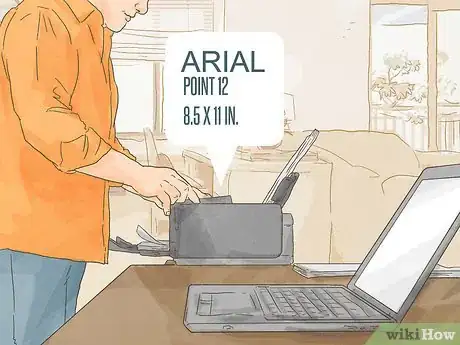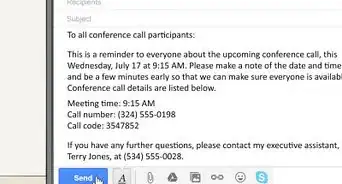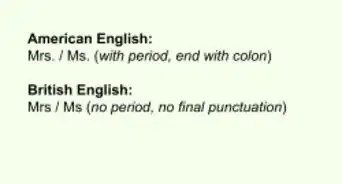This article was co-authored by wikiHow Staff. Our trained team of editors and researchers validate articles for accuracy and comprehensiveness. wikiHow's Content Management Team carefully monitors the work from our editorial staff to ensure that each article is backed by trusted research and meets our high quality standards.
This article has been viewed 119,868 times.
Learn more...
Businesses and non-profits create conflict of interest policies to ensure board members, employees, and managers do not seek personal gain while working for the organization. For example, a board member with a side business might offer their services for hire to the organization. This creates a conflict—is the board member hiring themselves because it is in the organization’s best interest, or in their own best interest? Most contracts and company policies include a conflict of interest statement to prohibit any activity that may lead to a conflict. A basic conflict of interest policy should explain what qualifies as a conflict and the steps your organization will take to analyze the conflict. You should also create a conflict disclosure form for employees to fill out.
Steps
Beginning Your Conflict of Interest Policy
-
1Find sample policies. Non-profits might lose their non-profit status if they don’t have a conflict of interest policy or an adequate one. The IRS used to publish a sample policy. However, you can still find copies on the Internet that are based on the IRS sample. You should find one and use it as a guide as you draft your own.
-
2State the purpose of the policy. Before getting into the details of the policy itself, you should explain the purpose for adopting it. Generally, you’ll adopt a conflict of interest policy to maintain integrity and protect the organization’s interests.
- For example, you can write something like the following: “Our organization strives to maintain the highest standards of integrity, and it is vital that the public be confident of our commitment. Accordingly, any appearance of a conflict must be avoided. To maintain our integrity and credibility, we have adopted the following policy.”
- If you’re a non-profit, you can write something like this: “The purpose of this policy is to protect the Organization’s tax-exempt status when contemplating a transaction or arrangement that could benefit an officer, director, or employee. This policy is intended to supplement but not replace any applicable state and federal laws governing conflict of interest that apply to non-profit organizations.”
Advertisement -
3Identify who has a duty to disclose. Be clear about who is covered by the policy. For example, you can write a disclosure policy for your board of directors and a separate one for your employees.
- You might call this person an “interested person” throughout the policy.
- Alternately, you could define “interested person” in your definition section.
-
4Include definitions. You need to clearly define certain terms that are used in your document, so that there isn’t any doubt as to what you are referring to. Provide definitions for all key terms, including the following:
- “Interested person”: You might define this as follows: “Any principal officer, director, or member of a committee with powers delegated by a governing board, who has a direct or indirect financial interest, as defined below.”
- “Financial interest”: You probably will define this broadly. For example, “A person has a Financial Interest if they have, directly or indirectly, any potential or actual ownership, compensation arrangement, or investment in any entity with which the Organization has a transaction or arrangement.”
- “Immediate family member”: Often means spouse or partner, and children. You may define it more broadly.
Explaining How Conflicts Are Managed
-
1Create the duty to disclose. State that interested persons have a duty to disclose conflicts of interest. Also identify who they must disclose their potential conflict to.
- Sample language might read: “An Interested Person shall disclose the existence of a Financial Interest and disclose all material facts to the directors. In an effort to aid the disclosure, each member shall complete a conflict-of-interest form as circumstances warrant, and no less frequently than annually.”
- Revise this language to suit your purposes. You might want someone to report a potential conflict to someone else.
-
2Explain how a disclosure statement should be filed. You should tell covered individuals to file an annual disclosure statement. Also remind them to disclose any conflict that arises during the year. Give them a deadline (such as 30 days).
- You could write: “Each individual covered by this policy must file an annual disclosure, which the Executive Vice President will review. As soon as any covered individual learns of a potential conflict, they must promptly disclose the circumstances to the EVP within 30 days and recuse him or herself until the matter is reviewed.”
-
3Describe how the organization decides if a conflict exists. Having employees or board members disclose the conflict is only part of the battle. You also need to state who will decide if there is a conflict.
- For example, if a board member has a conflict, they can make a presentation to the other board members. After the presentation, they leave and the board votes on whether there is a conflict of interest.
- If an employee reports a conflict, someone in management (such as the President or Vice President) can review to see if the conflict is significant. If it is, they can refer the matter to the Board of Directors, which will decide if a conflict or appearance of a conflict exists. They can then ask the employee to withdraw from the activity.
-
4Outline the steps for managing a conflict. Once a conflict exists, your organization must take certain steps to protect itself. For example, a non-profit should do the following:
- The board should determine whether they can with reasonable effort obtain a more advantageous arrangement or transaction. If they can’t, then the disinterested directors shall decide whether the transaction or arrangement is in the organization’s best interest, for its own benefit, and is fair and reasonable.
- You can also have the Chairperson of the Board appoint a disinterest person to investigate alternatives.
-
5Set out the penalties for an employee failing to comply. An employee or board member might not disclose a potential conflict. Accordingly, you may have to punish them. You should note in your policy that the board has the power to discipline the person.
- You might write: “If the committee has reason to believe an individual failed to disclose potential or actual conflicts, then it will inform the member. The member has a chance to explain the failure to disclose to the committee. If the committee still has reason to believe a conflict exists, it will take corrective action.”
-
6Craft policies for determining compensation. Sometimes conflicts arise when you are setting salaries for members of the organization. You need to set of clear policies outlining who can vote when salary discussions come up. For example, you’ll want the following policies:
- Members of the governing board who receive direct or indirect compensation cannot vote on matters related to their compensation.
- Members of committees whose committee handles compensation matters cannot vote on matters relating to their compensation.
- Nothing prohibits a voting member who receives direct or indirect compensation from providing information about compensation to any committee.
Completing the Policy
-
1Set out policies for recording the board’s proceedings. You need to adequately document the board’s response to potential conflicts. In your policy, include the following recordkeeping requirements:
- A requirement that the minutes contain the name of the person with a disclosed interest, the nature of the interest, and what action was taken to determine whether an actual conflict existed. Also note the board’s decision as to whether a conflict existed.
- A requirement that the minutes reflect the names of anyone present to discuss or vote on a transaction or arrangement, the content of the discussion, and the proposed alternatives. Also record the votes taken.
-
2Explain how you will periodically review your policy. The IRS requires non-profits to periodically review their conflict of interest policy. Accordingly, you should explain when and how you will do so. Your periodic review should cover the following, at a minimum:
- whether your compensation arrangements are the result of arm’s-length bargaining, reasonable, and based on credible survey information
- whether joint ventures, partnerships, and arrangements with management organizations comport with your written policies and are properly recorded
- whether these joint ventures reflect reasonable investment or payments for goods and services and do not result in impermissible private benefit or excess benefit transaction
-
3Provide further guidance on public activities. When your employees speak to the public, they should clarify whether they are speaking for the organization or on their own behalf. This can lessen any confusion about where the organization stands on issues.
- For example, you can include the following: “To avoid confusion, members who address the public should clarify if they are speaking as private individuals or speaking for the organization. Sometimes the organization is asked to speak publicly on issues, or to provide representatives to state boards. Requests will come to the Administrative Office and be reviewed by the Executive Vice President. If appropriate, the EVP will forward the information to the President.”
-
4Show your policy to a lawyer. This article describes a basic conflict of interest policy. Your organization might need additional or different information. You should consult with an attorney who is familiar with your organization.
- If you don’t yet have a lawyer, you can obtain a referral by contacting your local or state bar association.
- Call and schedule a consultation. Ask how much the lawyer charges.
Creating a Disclosure Form
-
1Find sample disclosure forms. Affected employees and board members should disclose potential conflicts annually. This annual disclosure does not replace their on-going duty to disclose any conflicts that arise throughout the year. You should draft a form as a template that you can use for all covered individuals.
- Ask other businesses or non-profits if they have a form you can look at. Use it as a guide when drafting your own.
-
2Format your document. Set one-inch margins on all sides and use 8.5x11 paper. Select a font size and style that is easy to read. Arial or Times 12 point is generally acceptable.
- You can title your form “Conflict of Interest Disclosure Form.”
-
3Explain the purpose of the form. You can provide a paragraph of information, reminding the person of the importance of disclosing potential conflicts of interest. Put this information right at the top, so that the reader won’t miss it.
- For example, you can write: “A potential or actual conflict of interest arises when your obligations are likely to be compromised by other material interests or relationships, especially when those interests are not disclosed. You should disclose any business, personal, or volunteer affiliations that could give rise to real or apparent conflicts.”
-
4Provide space for identifying information. You should provide blank lines for the date, the person’s name, and their position.
-
5Ask a series of questions. It might be easiest to set up your form as a questionnaire. You can ask the person filling it out to answer “Yes” or “No” to a series of questions. Provide a line for the person to give more information if they answer “yes.” You can ask the following questions:
- Do you serve as an officer of an organization that has a relationship or does business with us?
- Have you ever served as a director of a business in which our organization invests?
- Do you have a family relationship with anyone who has a noted relationship with our business? These family relationships include: spouse, parent, child, grandparent, grandchild, great-grandchild, and siblings. The spouse of any child, grandchild, great-grandchild, or sibling is also considered a family relationship.
- Have you ever participated in a compensation relationship, employment agreement, investment opportunity, or other arrangement, directly or indirectly, with a third-party vendor doing business with us that could personally benefit you?
- Have you ever received any direct or indirect loans, gifts, payments, discounts, fees, or free services from any organization or person engaged in any transaction with us?
- Do you share ownership of a business that does business with us? Ownership means voting power in a corporation, beneficial interest in a trust, or profits interest in a partnership.
-
6Insert a signature block. Provide lines for the person’s signature, printed name, and the date. After they sign, you should store the form for at least a year.
- Remember that this is confidential information which you shouldn’t share with other people. Safeguard the form as you would other confidential employee information.
About This Article
A conflict of interest statement outlines a policy to ensure no employees or board members make decisions for the company that would benefit their own personal interests. Search for a sample policy online so you don’t need to draft it from scratch. Make sure you define special terms like "interested person" at the end of the document. This will make it more clear which terms apply to which people. State that interested persons have the duty to disclose any conflicts of interest. Then, describe how conflicts will be resolved. For example, the interested person may be allowed to make a presentation, then the board can vote to decide if there’s a conflict. You should also describe the penalties for not disclosing their conflict of interest. For more tips, including how to create a disclosure form, read on!
















































































